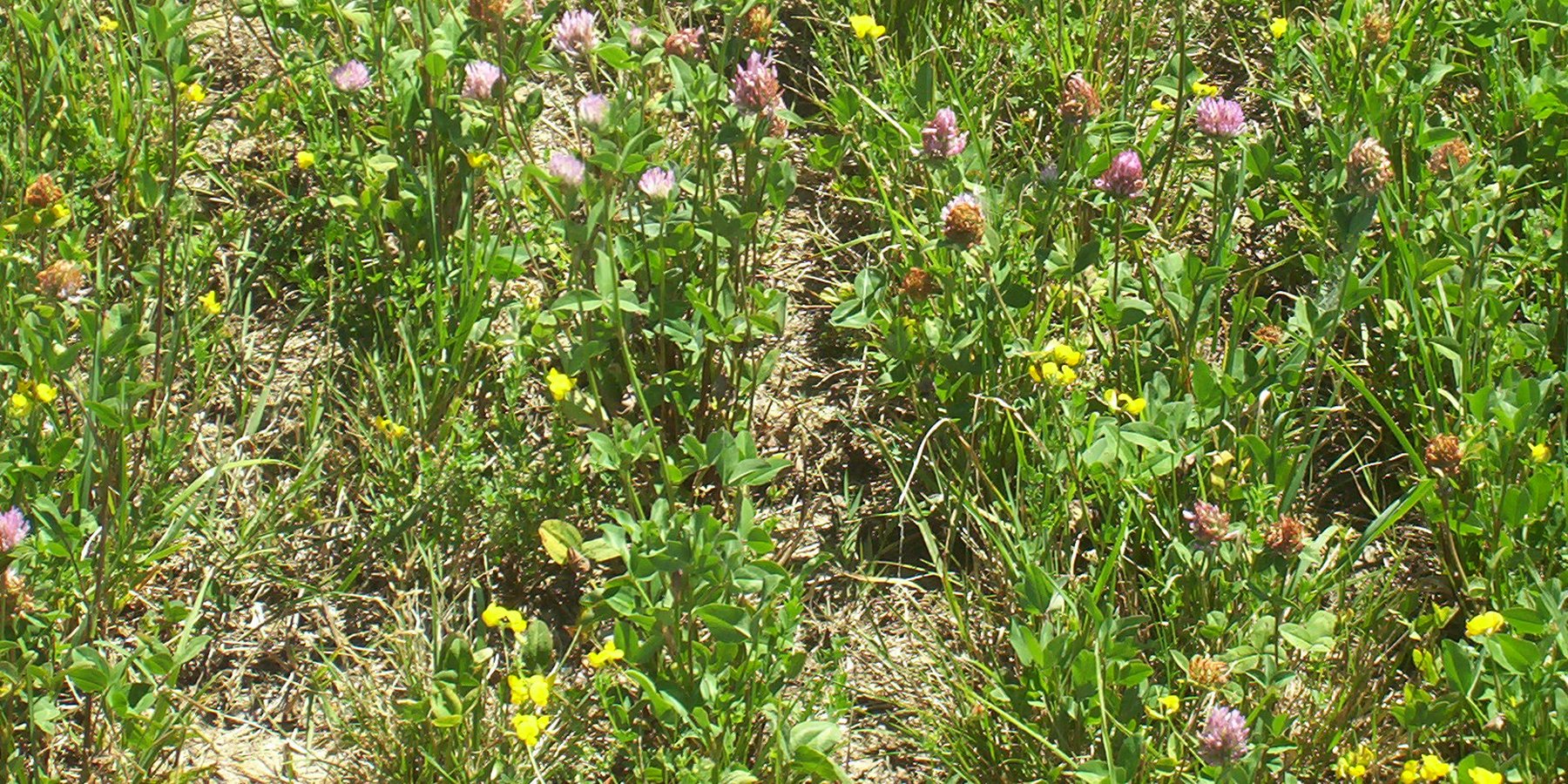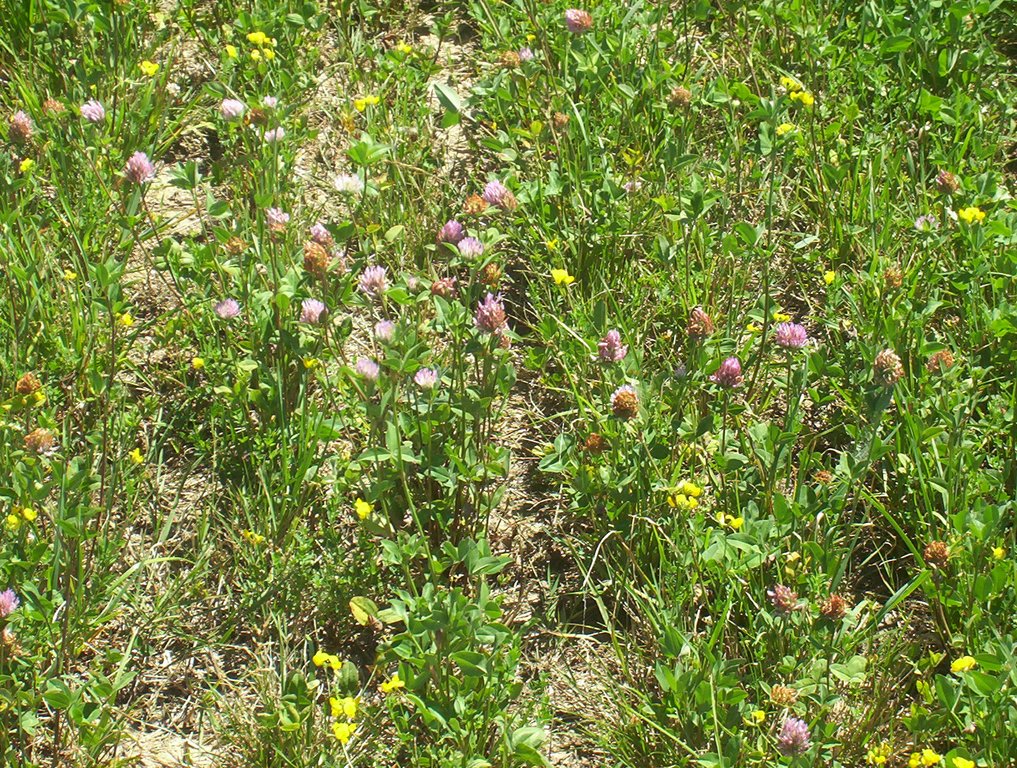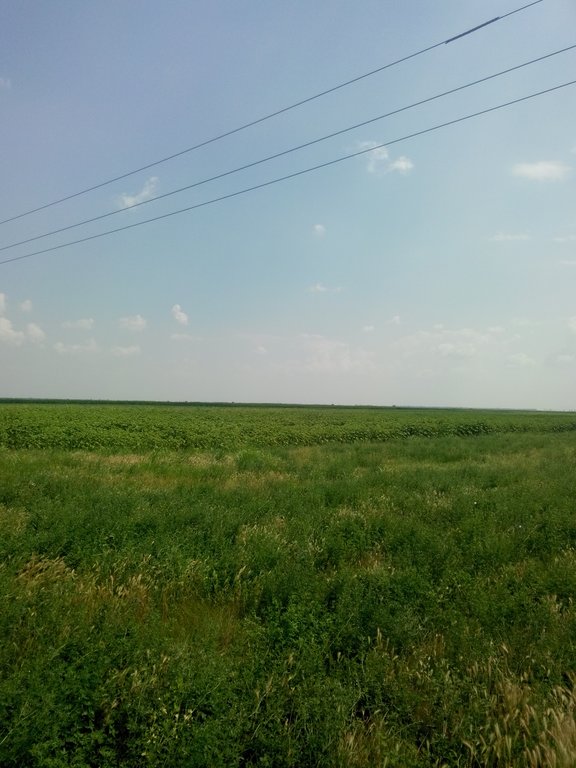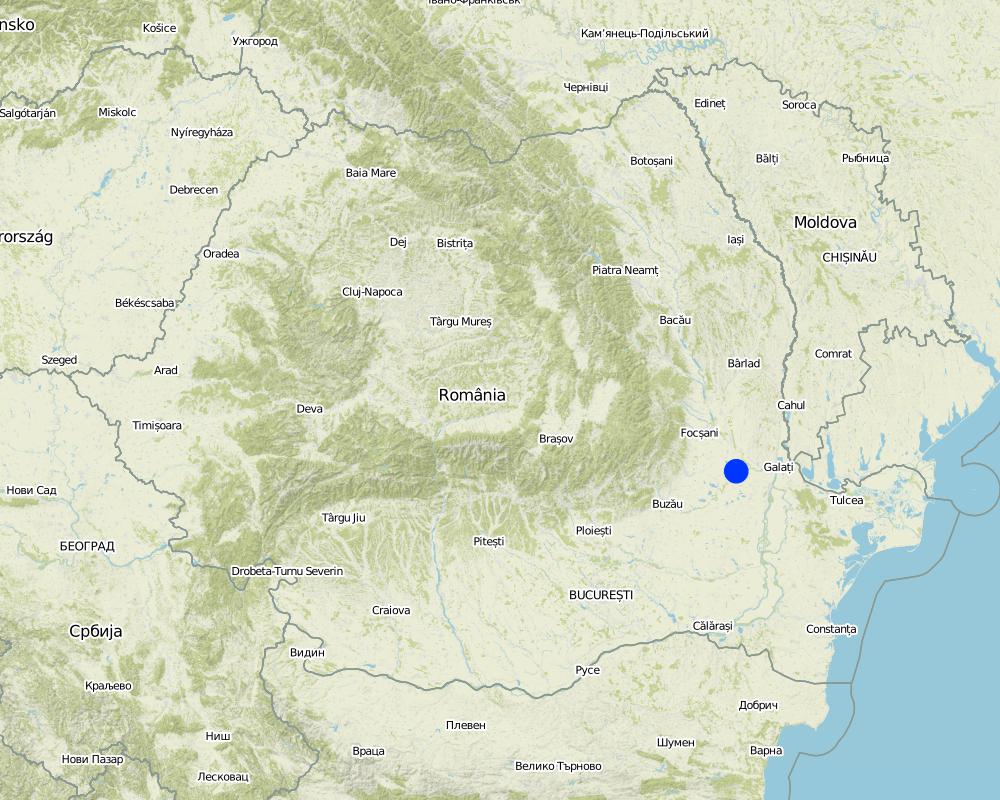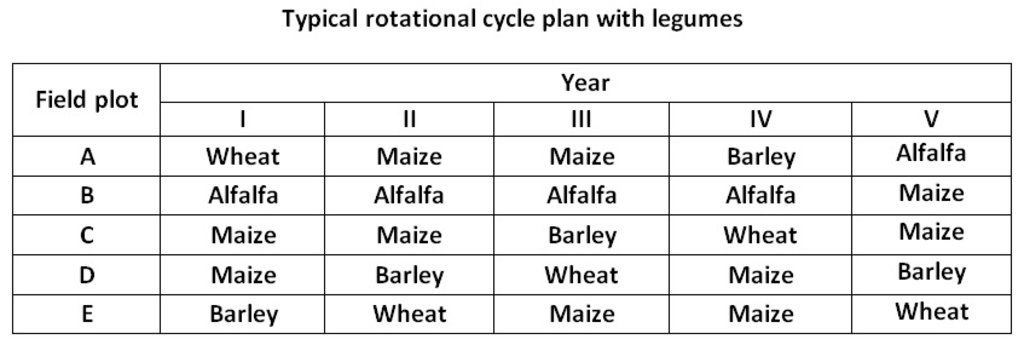Leguminous crop cultivated in plot temporarely set outside the crop rotation [Roumanie]
- Création :
- Mise à jour :
- Compilateur : Olga Vizitiu
- Rédacteur : –
- Examinateurs : Ursula Gaemperli, Gudrun Schwilch, Nina Lauterburg, Alexandra Gavilano
technologies_2963 - Roumanie
Voir les sections
Développer tout Réduire tout1. Informations générales
1.2 Coordonnées des personnes-ressources et des institutions impliquées dans l'évaluation et la documentation de la Technologie
Nom du projet qui a facilité la documentation/ l'évaluation de la Technologie (si pertinent)
Interactive Soil Quality assessment in Europe and China for Agricultural productivity and Environmental Resilience (EU-iSQAPER)Nom du ou des institutions qui ont facilité la documentation/ l'évaluation de la Technologie (si pertinent)
National Research and Development Institute for So (National Research and Development Institute for So) - Roumanie1.3 Conditions relatives à l'utilisation par WOCAT des données documentées
Le compilateur et la(les) personne(s) ressource(s) acceptent les conditions relatives à l'utilisation par WOCAT des données documentées:
Oui
1.4 Déclaration sur la durabilité de la Technologie décrite
Est-ce que la Technologie décrite ici pose problème par rapport à la dégradation des terres, de telle sorte qu'elle ne peut pas être déclarée comme étant une technologie de gestion durable des terres?
Non
2. Description de la Technologie de GDT
2.1 Courte description de la Technologie
Définition de la Technologie:
Introducing the leguminous crops in crop rotation to improve soil fertility, as field plot set temporarely outside the crop rotation. Crop rotation with legumes is an alternative to rotation containing only cereals.
2.2 Description détaillée de la Technologie
Description:
The technology is applied in Braila region and is located in north-eastern part of Romanian Plain. It has an agricultural area of 387,646 ha (of which 350,001 ha are arable land), and has specific geomorphologic, hydrological and climatic conditions which need to use ameliorative agricultural systems. Within Braila County are distinguished the following relief units: Calmatui Plain, part of the Braila Plain (51% from County area) and the Floodplains of Danube (Big Island of Braila), Siret, Buzau and Calmatui rivers (49% from County area).
Braila Plain is characterized by a specific micro-relief of Baragan type with large floodplains, poorly fragmented, with altitudes ranging between 20-25 m in the east part and 35-40 m to the west part, with soils mainly of chernozem type, formed on loess and loess deposits and which shows numerous small depression areas. Floodplains, areas adjacent to Danube, Siret, Buzau and Calmatui rivers are located at lower altitudes, ranging between 2-4 m and 13-15 m and are characterized by the presence of alluvial soils formed on river-limnic and alluvial deposits, with alternating of layers with different textures. According to United Nations Convention to Combat Desertification, Braila County is located in arid region with an average annual temperature of 10.9°C, long-term average annual precipitations (P) of 447 mm, potential evapotranspiration (ETP) of 705 mm (750-800 mm in dry years) and an average climatic water deficit of 258 mm (350-400 mm in dry years). The biophysical aridity index (P/ETP = 0.50-0.65) places the Braila region in area with moderate risk to desertification. Both intensive and extensive farming systems are practiced within Braila County. Intensive agriculture, characterized by high inputs and yield levels, is realized on large vegetal farms. On the other hand, extensive agriculture, with low input and yield levels, is practiced by farmers on small vegetal farms, and is so-called the semi-subsistent agriculture.
Crop rotation with legumes (such as alfalfa) is is generally limited to a maximum period of time of 5 to 6 years, providing a plant succesion of spring (generally maize, soybean, sunflower) and winter crops (such as wheat, rapeseed, barley). The technology consists of a crop rotation in which one parcel/field plot is cultivated with perennials legumes and set temporarily outside the crop rotation for 4-5 years. During this period, the field plot cultivated with perennials legumes recovers its fertility by improving the soil aeration status, water infiltration and storage rate and soil aggregate stability. Leguminous crops play an important role in crop rotation because it favors the fixation of atmospheric nitrogen and bind it into the soil with a significant increase in soil fertility. Crop rotation with legumes reduces the biocides use because it breaks the pest cycles and weeds. Leguminous crops also improve the soil structure and its stability, increases water permeability, soil biodiversity and soil quality. At the same time, crop rotation with legumes represents a supplemental income source for land users. After alfalfa baling, this is sold to the nearby livestock breeders.
Crop rotation with legumes has many advantages, such as increase of soil agro-ecosystem biodiversity, reduction of chemical inputs, reduction of soil structure degradation processes, increase of nutrient availability and consequently increase of soil fertility, and increase of farm income. Also in the land user's view, crop rotation with legumes may improve land productivity, even though it increase the costs of inputs and management for crop establishment, and for this reason the land user's awareness is low.
2.3 Photos de la Technologie
2.5 Pays/ région/ lieux où la Technologie a été appliquée et qui sont couverts par cette évaluation
Pays:
Roumanie
Région/ Etat/ Province:
Braila
Autres spécifications du lieu:
Braila
Spécifiez la diffusion de la Technologie:
- répartie uniformément sur une zone
S'il n'existe pas d'informations exactes sur la superficie, indiquez les limites approximatives de la zone couverte:
- < 0,1 km2 (10 ha)
Commentaires:
Documentation of the technology is based on examination of field plot smaller than 0.1 km2.
Map
×2.6 Date de mise en œuvre de la Technologie
Si l'année précise est inconnue, indiquez la date approximative: :
- il y a moins de 10 ans (récemment)
2.7 Introduction de la Technologie
Spécifiez comment la Technologie a été introduite: :
- grâce à l'innovation d'exploitants des terres
3. Classification de la Technologie de GDT
3.1 Principal(aux) objectif(s) de la Technologie
- améliorer la production
- réduire, prévenir, restaurer les terres dégradées
3.2 Type(s) actuel(s) d'utilisation des terres, là où la Technologie est appliquée

Terres cultivées
- Cultures annuelles
Cultures annuelles - Précisez les cultures:
- céréales - orge
- céréales - maïs
- cultures fourragères - luzerne
Nombre de période de croissance par an: :
- 1
Commentaires:
crop rotation of 5-6 years, with one field plot set temporarely outside the crop rotation cultivated with perennial legumes (alfalfa)
3.4 Approvisionnement en eau
Approvisionnement en eau des terres sur lesquelles est appliquée la Technologie:
- pluvial
3.5 Groupe de GDT auquel appartient la Technologie
- système de rotation (rotation des cultures, jachères, agriculture itinérante)
- gestion intégrée de la fertilité des sols
3.6 Mesures de GDT constituant la Technologie

pratiques agronomiques
- A2: Matière organique/ fertilité du sol
Commentaires:
Introducing of a perennial crop (alfalfa) in a crop rotation with cereals
3.7 Principaux types de dégradation des terres traités par la Technologie
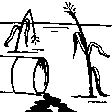
dégradation chimique des sols
- Cn: baisse de la fertilité des sols et réduction du niveau de matière organique (non causée par l’érosion)
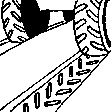
dégradation physique des sols
- Pu: perte de la fonction de bio-production en raison d’autres activités
3.8 Prévention, réduction de la dégradation ou réhabilitation des terres dégradées
Spécifiez l'objectif de la Technologie au regard de la dégradation des terres:
- réduire la dégradation des terres
4. Spécifications techniques, activités, intrants et coûts de mise en œuvre
4.1 Dessin technique de la Technologie
Spécifications techniques (associées au dessin technique):
The technology consists of a crop rotation in which one parcel/field plot is cultivated with perennial crop (alfalfa) and set temporarily outside the crop rotation for 4-5 years. During this period, the field plot cultivated with perennial crop recovers its fertility by improving the soil aeration status, water infiltration and storage rate and soil aggregate stability.
After completing one rotational cycling plan, the field plot cultivated with perennial crop will be set in another plot from the crop rotation, until all the plots of the rotation plan will be cultivated with perennial crop.
Auteur:
National Research and Development Institute for Soil Science, Agrochemistry and Environment (ICPA) - Romania
4.2 Informations générales sur le calcul des intrants et des coûts
Spécifiez la manière dont les coûts et les intrants ont été calculés:
- par superficie de la Technologie
Indiquez la taille et l'unité de surface:
1 ha
Indiquez la monnaie utilisée pour le calcul des coûts:
- dollars américains
Indiquez le taux de change des USD en devise locale, le cas échéant (p.ex. 1 USD = 79.9 réal brésilien): 1 USD = :
4,12
Indiquez le coût salarial moyen de la main d'œuvre par jour:
17.60 USD
4.3 Activités de mise en place/ d'établissement
| Activité | Calendrier des activités (saisonnier) | |
|---|---|---|
| 1. | fertilisation | after harvest of previous crop |
| 2. | ploughing | after harvest of previous crop |
| 3. | seedbed preparation | after ploughing |
| 4. | alfalfa sowing | autumn |
| 5. | fertilisation | spring |
| 6. | chemical weeds control | spring - summer |
| 7. | pest control | spring - summer |
| 8. | alfalfa cutting | summer |
| 9. | alfalfa baling | summer |
4.4 Coûts et intrants nécessaires à la mise en place
| Spécifiez les intrants | Unité | Quantité | Coûts par unité | Coût total par intrant | % du coût supporté par les exploitants des terres | |
|---|---|---|---|---|---|---|
| Main d'œuvre | labor | person-days | 3,0 | 17,6 | 52,8 | 100,0 |
| Equipements | fertilisation | machine-hours | 1,0 | 13,37 | 13,37 | 100,0 |
| Equipements | ploughing | machine-hours | 3,0 | 12,39 | 37,17 | 100,0 |
| Equipements | seedbed preparation | machine-hours | 2,0 | 19,67 | 39,34 | 100,0 |
| Equipements | alfalfa sowing | machine-hours | 1,0 | 17,32 | 17,32 | 100,0 |
| Equipements | fertilisation | machine-hours | 1,0 | 13,37 | 13,37 | 100,0 |
| Equipements | herbicides & pests control | machine-hours | 2,0 | 8,4 | 16,8 | 100,0 |
| Equipements | alfalfa cutting | machine-hours | 1,0 | 50,96 | 50,96 | 100,0 |
| Equipements | alfalfa baling | machine-hours | 2,0 | 36,4 | 72,8 | 100,0 |
| Matériel végétal | alfalfa seeds | kg/ha | 22,0 | 6,12 | 134,64 | 100,0 |
| Engrais et biocides | complex fertilizers | kg/ha | 150,0 | 0,28 | 42,0 | 100,0 |
| Engrais et biocides | ammonium nitrate | kg/ha | 200,0 | 0,14 | 28,0 | 100,0 |
| Engrais et biocides | herbicides | l/ha | 0,5 | 13,75 | 6,88 | 100,0 |
| Engrais et biocides | biocides | l/ha | 0,1 | 110,55 | 11,05 | 100,0 |
| Coût total de mise en place de la Technologie | 536,5 | |||||
| Coût total de mise en place de la Technologie en dollars américains (USD) | 130,22 | |||||
4.5 Activités d'entretien/ récurrentes
| Activité | Calendrier/ fréquence | |
|---|---|---|
| 1. | fertilisation | spring |
| 2. | herbicides & pests control | spring - summer |
| 3. | alfalfa cutting | summer |
| 4. | alfalfa baling | summer |
4.6 Coûts et intrants nécessaires aux activités d'entretien/ récurrentes (par an)
| Spécifiez les intrants | Unité | Quantité | Coûts par unité | Coût total par intrant | % du coût supporté par les exploitants des terres | |
|---|---|---|---|---|---|---|
| Main d'œuvre | labor | person-days | 1,0 | 17,6 | 17,6 | 100,0 |
| Equipements | fertilisation | machine-hours | 1,0 | 13,37 | 13,37 | 100,0 |
| Equipements | herbicides & pests control | machine-hours | 2,0 | 8,4 | 16,8 | 100,0 |
| Equipements | alfalfa cutting | machine-hours | 1,0 | 50,96 | 50,96 | 100,0 |
| Equipements | alfalfa baling | machine-hours | 2,0 | 36,4 | 72,8 | 100,0 |
| Engrais et biocides | ammonium nitrate | kg/ha | 200,0 | 0,14 | 28,0 | 100,0 |
| Engrais et biocides | herbicides | l/ha | 0,5 | 13,75 | 6,88 | 100,0 |
| Engrais et biocides | biocides | l/ha | 0,1 | 110,55 | 11,05 | 100,0 |
| Coût total d'entretien de la Technologie | 217,46 | |||||
| Coût total d'entretien de la Technologie en dollars américains (USD) | 52,78 | |||||
4.7 Facteurs les plus importants affectant les coûts
Décrivez les facteurs les plus importants affectant les coûts :
Certified seed material and costs with alfalfa cutting and baling are the most determining factors affecting the costs.
5. Environnement naturel et humain
5.1 Climat
Précipitations annuelles
- < 250 mm
- 251-500 mm
- 501-750 mm
- 751-1000 mm
- 1001-1500 mm
- 1501-2000 mm
- 2001-3000 mm
- 3001-4000 mm
- > 4000 mm
Spécifiez la pluviométrie moyenne annuelle (si connue), en mm:
447,00
Zone agro-climatique
- semi-aride
5.2 Topographie
Pentes moyennes:
- plat (0-2 %)
- faible (3-5%)
- modéré (6-10%)
- onduleux (11-15%)
- vallonné (16-30%)
- raide (31-60%)
- très raide (>60%)
Reliefs:
- plateaux/ plaines
- crêtes
- flancs/ pentes de montagne
- flancs/ pentes de colline
- piémonts/ glacis (bas de pente)
- fonds de vallée/bas-fonds
Zones altitudinales:
- 0-100 m
- 101-500 m
- 501-1000 m
- 1001-1500 m
- 1501-2000 m
- 2001-2500 m
- 2501-3000 m
- 3001-4000 m
- > 4000 m
Indiquez si la Technologie est spécifiquement appliquée dans des:
- non pertinent
5.3 Sols
Profondeur moyenne du sol:
- très superficiel (0-20 cm)
- superficiel (21-50 cm)
- modérément profond (51-80 cm)
- profond (81-120 cm)
- très profond (>120 cm)
Texture du sol (de la couche arable):
- moyen (limoneux)
Texture du sol (> 20 cm sous la surface):
- moyen (limoneux)
Matière organique de la couche arable:
- moyen (1-3%)
5.4 Disponibilité et qualité de l'eau
Profondeur estimée de l’eau dans le sol:
5-50 m
Disponibilité de l’eau de surface:
moyenne
La salinité de l'eau est-elle un problème? :
Non
La zone est-elle inondée?
Non
5.5 Biodiversité
Diversité des espèces:
- moyenne
Diversité des habitats:
- moyenne
5.6 Caractéristiques des exploitants des terres appliquant la Technologie
Sédentaire ou nomade:
- Sédentaire
Orientation du système de production:
- exploitation mixte (de subsistance/ commerciale)
Revenus hors exploitation:
- moins de 10% de tous les revenus
Niveau relatif de richesse:
- pauvre
Individus ou groupes:
- individu/ ménage
Niveau de mécanisation:
- mécanisé/ motorisé
Genre:
- hommes
Age des exploitants des terres:
- personnes d'âge moyen
Indiquez toute autre caractéristique pertinente des exploitants des terres:
The technology was firstly implemented by the farmer in the year of 2008.
5.7 Superficie moyenne des terres utilisées par les exploitants des terres appliquant la Technologie
- < 0,5 ha
- 0,5-1 ha
- 1-2 ha
- 2-5 ha
- 5-15 ha
- 15-50 ha
- 50-100 ha
- 100-500 ha
- 500-1 000 ha
- 1 000-10 000 ha
- > 10 000 ha
Cette superficie est-elle considérée comme de petite, moyenne ou grande dimension (en se référant au contexte local)?
- moyenne dimension
5.8 Propriété foncière, droits d’utilisation des terres et de l'eau
Propriété foncière:
- individu, sans titre de propriété
- individu, avec titre de propriété
Droits d’utilisation des terres:
- loué
5.9 Accès aux services et aux infrastructures
santé:
- pauvre
- modéré
- bonne
éducation:
- pauvre
- modéré
- bonne
assistance technique:
- pauvre
- modéré
- bonne
emploi (par ex. hors exploitation):
- pauvre
- modéré
- bonne
marchés:
- pauvre
- modéré
- bonne
énergie:
- pauvre
- modéré
- bonne
routes et transports:
- pauvre
- modéré
- bonne
eau potable et assainissement:
- pauvre
- modéré
- bonne
services financiers:
- pauvre
- modéré
- bonne
6. Impacts et conclusions
6.1 Impacts sur site que la Technologie a montrés
Impacts socio-économiques
Production
production fourragère
Commentaires/ spécifiez:
Increases competition among feed suppliers in the nearby area, so the animal breeders can have more options of sources from which they can buy feed for animals.
diversité des produits
Commentaires/ spécifiez:
By introducing the alfalfa crop in rotation, the land user diversifies the farm crop plan and also increases the income of the farm by selling alfalfa balls to the nearby animal breeders.
Revenus et coûts
diversité des sources de revenus
Commentaires/ spécifiez:
The hay baling production and selling of the hay bales outside the farm is an additional source of income for the land user.
Impacts socioculturels
connaissances sur la GDT/ dégradation des terres
Commentaires/ spécifiez:
The land user gains knowledge concerning the efficiency of alfalfa in soil protection against degradation processes such as soil organic matter loss.
Impacts écologiques
Sols
matière organique du sol/ au dessous du sol C
Commentaires/ spécifiez:
Cultivation of the alfalfa improves the soil organic matter content.
Biodiversité: végétale, animale
espèces bénéfiques
Commentaires/ spécifiez:
Alfalfa plants are attractive to pollinators.
contrôle des animaux nuisibles/ maladies
Commentaires/ spécifiez:
Crop rotation with legumes reduces the biocides use because it breaks the pest cycles and weeds.
6.3 Exposition et sensibilité de la Technologie aux changements progressifs et aux évènements extrêmes/catastrophes liés au climat (telles que perçues par les exploitants des terres)
Changements climatiques progressifs
Changements climatiques progressifs
| Saison | Augmentation ou diminution | Comment la Technologie fait-elle face à cela? | |
|---|---|---|---|
| températures annuelles | augmente | bien | |
| précipitations annuelles | décroît | bien |
Extrêmes climatiques (catastrophes)
Catastrophes météorologiques
| Comment la Technologie fait-elle face à cela? | |
|---|---|
| pluie torrentielle locale | bien |
6.4 Analyse coûts-bénéfices
Quels sont les bénéfices comparativement aux coûts de mise en place (du point de vue des exploitants des terres)?
Rentabilité à court terme:
neutre / équilibrée
Rentabilité à long terme:
légèrement positive
Quels sont les bénéfices comparativement aux coûts d'entretien récurrents (du point de vue des exploitants des terres)?
Rentabilité à court terme:
neutre / équilibrée
Rentabilité à long terme:
positive
6.5 Adoption de la Technologie
- cas isolés/ expérimentaux
De tous ceux qui ont adopté la Technologie, combien d'entre eux l'ont fait spontanément, à savoir sans recevoir aucune incitation matérielle, ou aucune rémunération? :
- 91-100%
Commentaires:
One land user has implemented the technology voluntary.
6.6 Adaptation
La Technologie a-t-elle été récemment modifiée pour s'adapter à l'évolution des conditions?
Non
6.7 Points forts/ avantages/ possibilités de la Technologie
| Points forts/ avantages/ possibilités du point de vue de l'exploitant des terres |
|---|
| Improve land productivity |
| Points forts/ avantages/ possibilités du point de vue du compilateur ou d'une autre personne ressource clé |
|---|
| Improve soil fertility, soil structure, organic matter content and biodiversity. |
| Improve natural control of the weeds. |
6.8 Faiblesses/ inconvénients/ risques de la Technologie et moyens de les surmonter
| Faiblesses/ inconvénients/ risques du point de vue de l’exploitant des terres | Comment peuvent-ils être surmontés? |
|---|---|
| Increase costs of inputs and management for crop establishment | increase awareness on long-term about soil benefits and subsidies |
| Land users awareness is low | education and training |
| Faiblesses/ inconvénients/ risques du point de vue du compilateur ou d'une autre personne ressource clé | Comment peuvent-ils être surmontés? |
|---|---|
| no weakness from compiler's view |
7. Références et liens
7.1 Méthodes/ sources d'information
- visites de terrain, enquêtes sur le terrain
1
- interviews/entretiens avec les exploitants des terres
1
Quand les données ont-elles été compilées (sur le terrain)?
20/06/2017
Liens et modules
Développer tout Réduire toutLiens
Aucun lien
Modules
Aucun module trouvé


